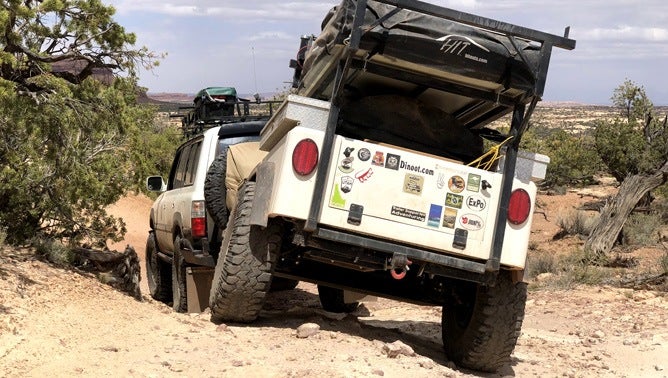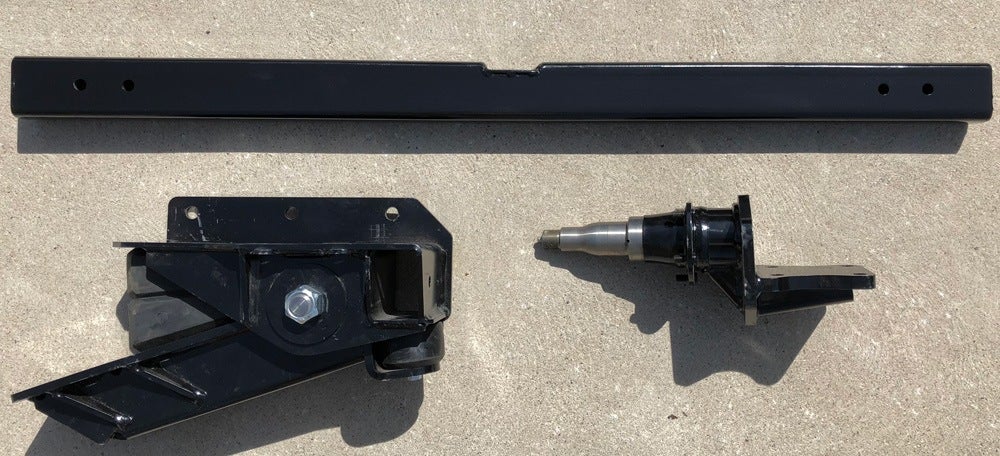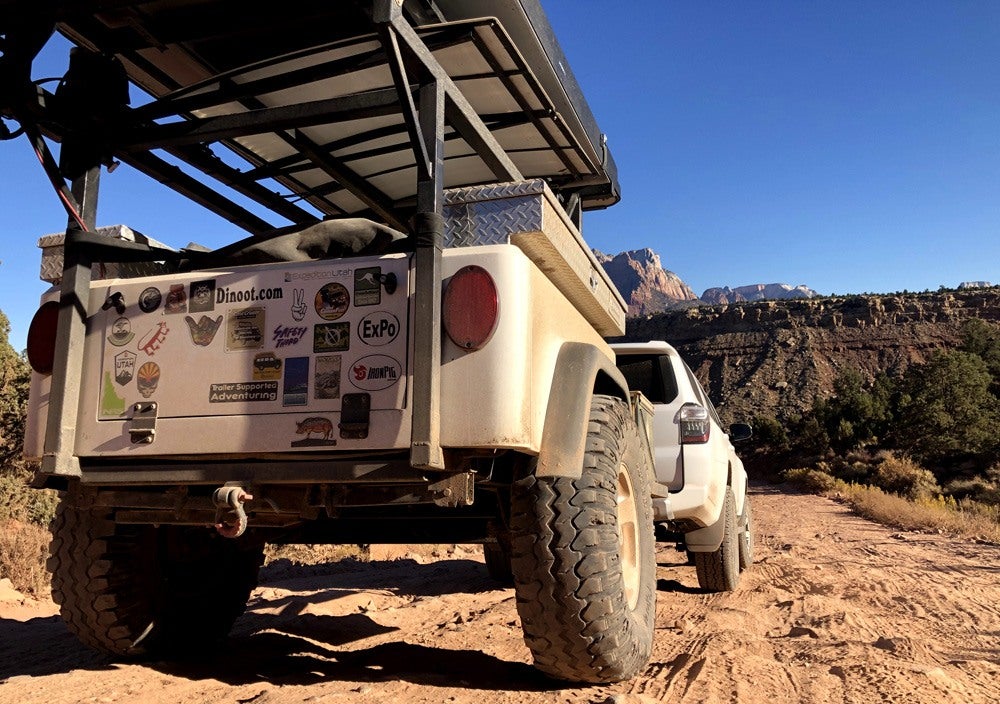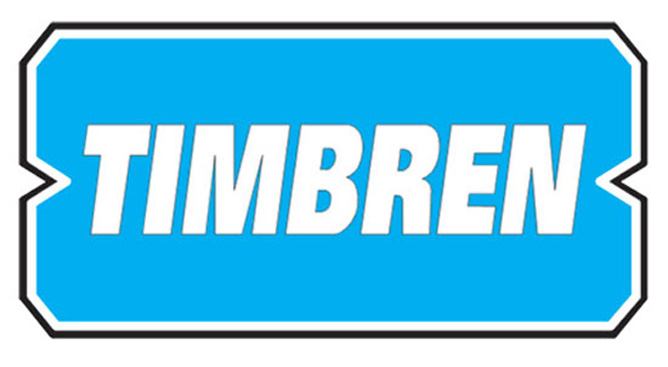The Timbren Axle-Less trailer suspension is an incredibly durable and trail-capable system that offers improved clearance.
Looking in my rearview mirror, the object that blocked the road behind was still there, sticking to us like glue, though following somewhat erratically. Which was, in fact, impressive, as haste and not caution described the pace our Land Cruiser was making. Perhaps frantic was actually a better description, because the backtracking my friend and I were doing was a race against time to find the trailhead we’d only recently left. And, more specifically, to find the prescription eyeglasses I’d accidentally left there on the ground.
The darting, bouncing object that shadowed the Toyota was an overland trailer. It was forced to trace the high-balling we did across Utah’s LaSal Mountains as we abandoned hope of reaching Moab, and instead did a 180 back to the Kokopelli Trail. If you tow a trailer on 4×4 trails, this harsh saga of a trailer forced to keep pace with the tow vehicle may sound familiar. In the backcountry, trailers get little sympathy. When push comes to shove, they need to hold their own.
It’s this demand for performance (including a certain amount of forgetfulness by drivers) that puts strains on trailers, their design, and their central components: hitch, frame and suspension. Thankfully there are several robust articulating hitch designs now available on the North American market. Frames, too, are not difficult to make plenty strong (if not overly heavy). But the brunt of the abuse is taken by a trailer’s suspension, and in that realm the rapidly growing trailer market offers few options.
Table of contents
Building an Off-road Trailer Suspension
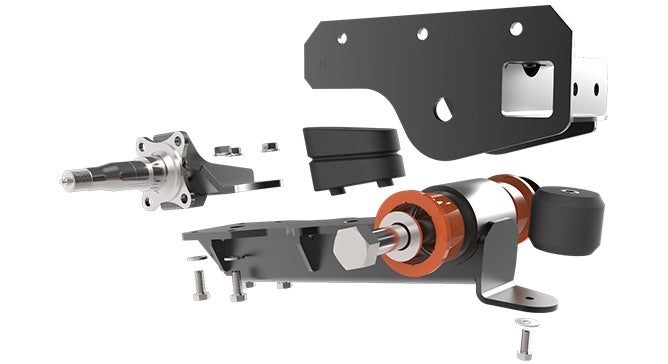
Timbren Industries is the rare company that’s developed a mass-produced suspension system for off-road trailers. While most trailers adapt a street-oriented leaf spring and solid axle suspension, Timbren opted to create a rugged alternative design, and to make it with numerous sizing options.
The backstory for its suspension is rooted in the Aeon rubber springs that Timbren had previously developed, and a U.S. military call for an off-road capable trailer suspension. While a lot of product R&D ensued, a military contract never panned out. However, the Axle-Less Trailer Suspension did. And in response, SEMA judges gave it a 2011 award for the show’s best new off-road product.
Shop for Timbren Suspension Systems
Today, Timbren offers its Axle-Less Suspension in a variety of sizes and options. And although they’re not solely meant for trail use (they are applicable for work/utility trailers as well), the design is specifically engineered to handle off-pavement abuse, and to offer several trail performance benefits.
As its name implies, the Axle-Less Suspension is unique for having created independent suspension arms that eliminate clearance issues by losing the need for a solid axle. Secondly, it’s built around a very simple pivot arm that incorporates Timbren’s Aeon rubber in both a compression and rebound “spring”. A pair of these arms constitutes a full suspension.
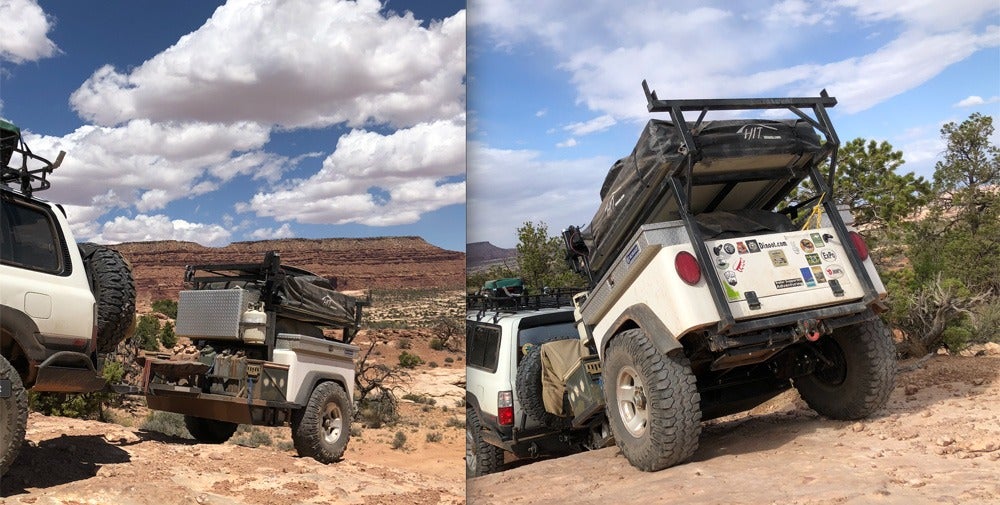
Timbren offers numerous suspension configurations through a mix of capacity ratings –400 pounds to 7,000 pounds – and height options. Spindle options mean the same suspension arms can be fitted to produce higher or lower wheel positions. The spindles are offered in 4” or 2” lifts, 4” drop, and Regular height. Timbren also offers HD (heavy duty) versions whose construction is amplified for the stresses of off-road travel.
To handle the additional loads placed on an independent suspension arm design, Timbren had to engineer a very beefy system. Weighing 46 pounds each (not counting spindle, hub or brakes), the massive arms and spindles are largely constructed of ¼” and ½” plate steel, with spindle mounts being a full 5/8” thick. Welded and powder-coated, the resulting system is serviceable thanks to a greaseable polyurethane bushing used for in the main pivot.
Swapping Systems
Like many Timbren customers, our trailer began with a different suspension. Our Dinoot trailer was, like so many in the off-road/overland community, a custom build. While it utilized the Dinoot kit for its box/platform, the rest was built from scratch. The build began with a simple, proven leaf spring/shackle system that Scott Chaney, owner of Dinoot, recommended. Coupled with a 3500-pound solid axle, the system was basic, commonplace, and reliable.
Unfortunately, such systems are also prone to all the dynamic behaviors of solid axle leaf spring suspensions on vehicles. Without appropriate shocks, they go beyond “lively” in their behavior and become downright dynamic. To resolve that characteristic we had installed shocks after a few years. Never an easy feat, this after-the-fact addition of the shocks tamed but never fully eliminated the pitch and rocking action.
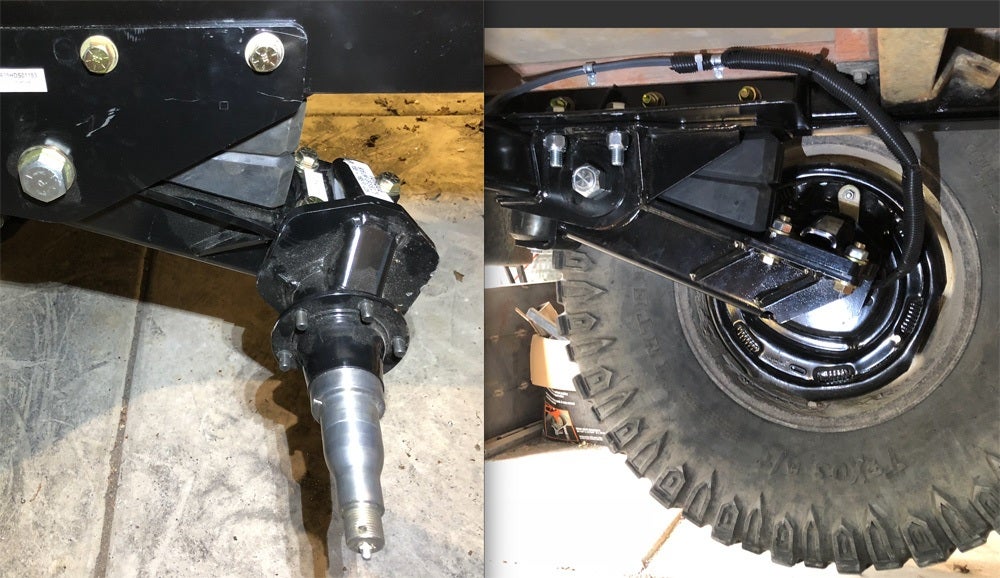
With the Timbren system, leaf springs are no longer necessary, and can be cut off. Their Axle-Less Suspension bolts to frame members, its main “L” structure designed to fit snugly against steel rails. While bolt-on attachment is likely adequate for use on pavement, we chose to incorporate Timbren’s option for a cross-member. Each suspension mount incorporates a sleeve designed to accommodate a 2”x2” or 2”x3” boxed steel tube that links together the left and right armatures. Through this simple step the system is dramatically strengthened, while adding only 15-20 pounds. The total system weighs around 200 pounds, which adds to a low center of gravity and cross slope stability thanks to the outward position of the arms’ mass.
If the addition of a cross-member sounds suspiciously like Timbren is reintroducing the old nemesis of a solid axle, the comparison is understandable. What’s different is that the optional crossmember is positioned up high, and thus ground clearance is fully 5” greater. With a 34” diameter tire, the clearance to the crossmember is 18”, with clearance to the bottom of each arm being fully 13”. It’s also worth noting that the Timbren arms feature an angled surface that acts like a skid plate, offering little for rocks to catch on.
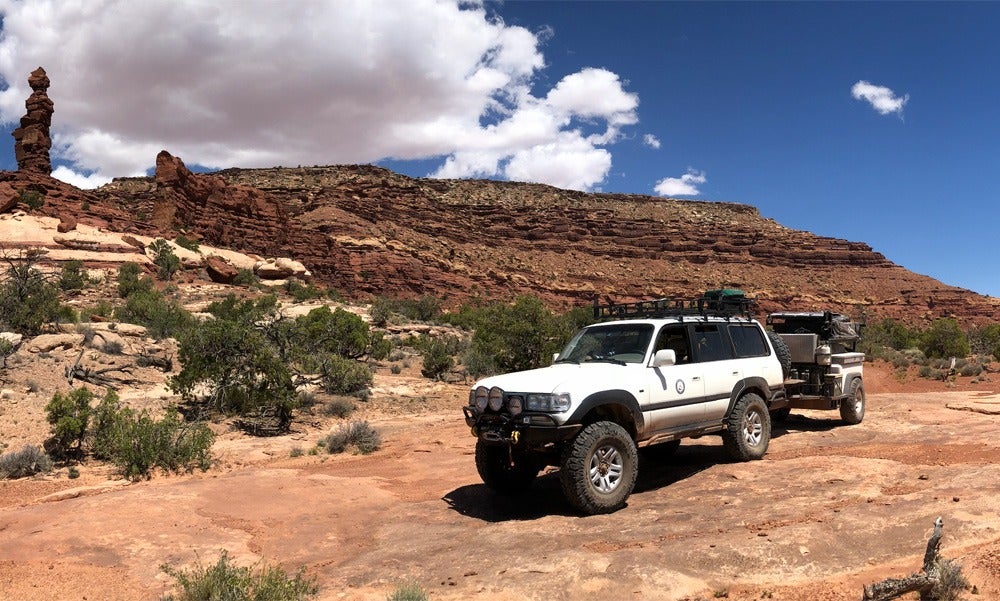
Unequivocally, it’s much easier to install a suspension at the outset of a trailer build. Upside-down cutting/grinding/welding/drilling/painting on a trailer supported with jack stands is no fun. Fortunately, the Timbren system requires a minimal mounting surface (21” of total frame; 17” of that being forward of the desired spindle location). As a result, adapting it to an existing trailer is very doable, although doing so with the trailer laid on its side will prove easier.
Total time necessary for removing the original leaf spring/solid axle suspension was approximately three hours, excluding repainting. Mounting the two Axe-Less Suspension systems, along with the cross member, required more than six hours working solo. Depending upon your trailer’s frame, and if you have help, those figures could vary, and exclude making brackets or cross-member
As with any suspension, precision mounting and alignment is essential if tracking and tire wear aren’t to be an issue. Here again, mounting this or any other suspension will be easiest when the trailer’s frame is new and/or upside down for ease of work. An inverted frame also allows gravity to assist rather than hinder the positioning and attachment of the unwieldy armatures.
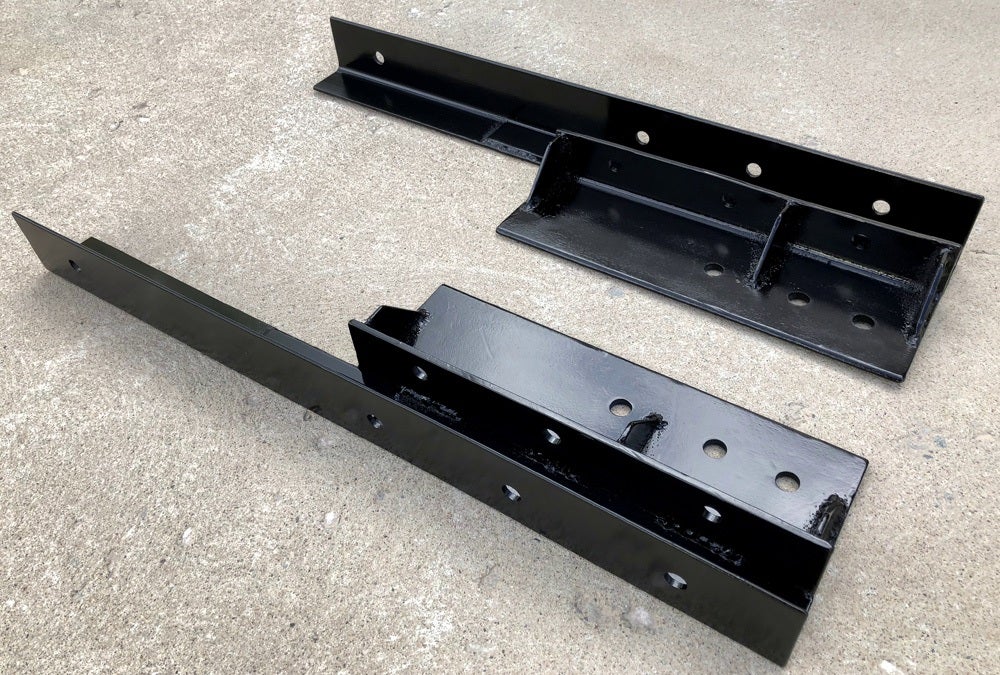
For mounting, Timbren recommends bolting each armature to the frame. While welding is also possible, the bolt-on design eases the process. Based upon our trailer’s 3/16” wall frame, we chose to add additional brackets to reinforce the rails. Use of thicker walled tubing for the rails would alleviate this need if a trailer were designed for the Timbren system from the outset. Also, mounting to 2×3” frame rails will prove easier than 2” square rails.
Timbren’s spindles use an integrated 4-bolt mounting plate to mount to the top surface of each suspension arm. The system may raise some eyebrows, but never required adjustment or tightening. This system offers subtle adjustments (toe and camber), and ours was set with about a 3-degree negative camber.
Fitting wheels with all major bolt patterns is possible thanks to the various hubs that Timbren offers to pair with the suspension’s spindles. We selected standard Toyota 6-bolt hubs, and opted to upgrade to electric brakes in the process. Simple electric drum brake systems are widely used on trailers, produce ample braking power, and offer easily sourced parts.
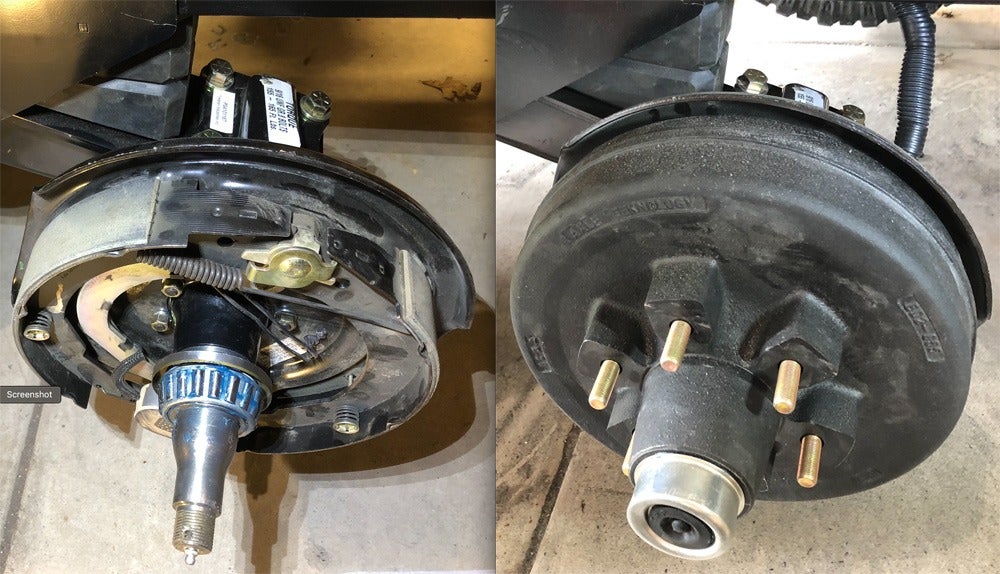
When adding the brakes, Etrailer was a valuable source for wiring, junction boxes, etc. We incorporated an Epicord 7-way cord/box combination that provides weather resistance and an ample length of heavy wiring for connecting to the tow vehicle.
Timbren has also helped tame the suspensions of 4x4s themselves. The company’s SES (Suspension Enhancement System) components are designed to assist a vehicle’s suspension by adding an auxiliary compression absorption system. Working in conjunction with OEM springs, and helping eliminate the need for an air bag system, Timbren designed these Aeon rubber “springs” as simple bolt-on solutions. We outfitted both our Trail Edition 4Runner and 80 Series Land Cruiser with these innovative products. Offered for trailers as well, the SES system has a special application in the off-road market where impacts from trail surfaces, as well as heavy loads, threaten to bottom out suspensions.
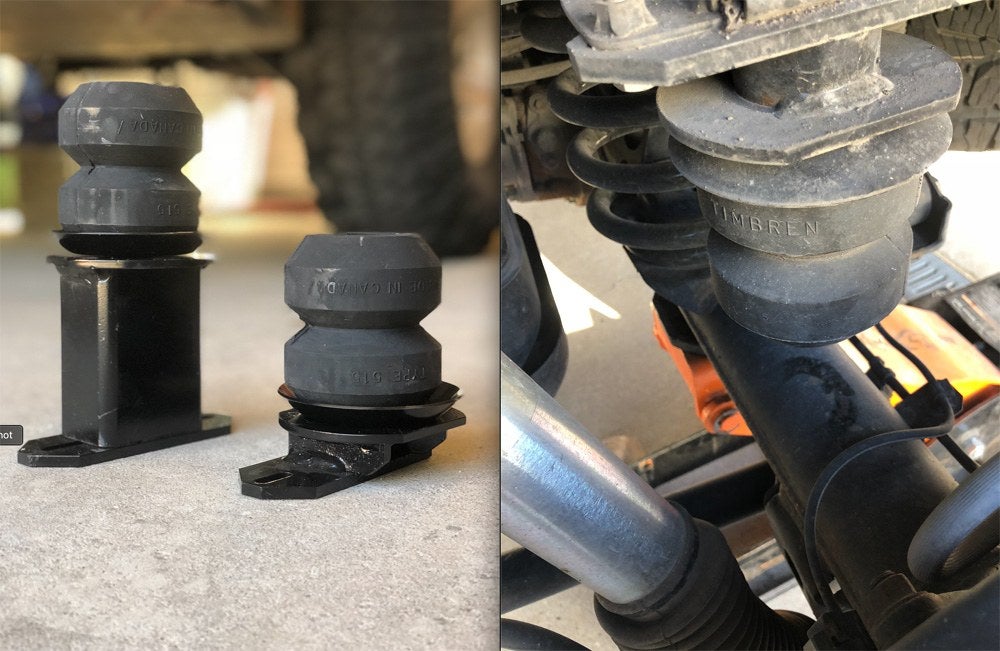
Fitment of the SES springs can, in situations where aftermarket suspension components are used (e.g., larger diameter coil springs), require double-checking clearances and sizing. Thanks to a very thorough, responsive and knowledgeable tech team at Timbren, I didn’t find this to be a problem. However, each vehicle is different, so it pays to talk with a tech specialist to confirm fitments. This especially applies with lifted suspensions, which may create too great a gap between the SES and the surface (e.g., axle tube) it is intended to contact. In those situations, a mounting spacer may be needed.
Hitting the Trails (and Street)
Pulling out of the shop with the Timbren-equipped Dinoot in tow, the trailer’s new behavior was immediately apparent. Solid. Firm. Stable. Predictable. Precise. Muted. By comparison, the leaf sprung suspension was lively, dynamic, springy, and compliant.
Thanks to a dialed-in 109” trailer wheelbase (axle to hitch pivot), our Dinoot had always tracked like a dream. But when the surface gets rough, tracking alone isn’t enough. A trailer’s suspension is proven by its reaction to changing trail and pavement surfaces, and whether it forces the tow rig to slow down for fear of loss of control.
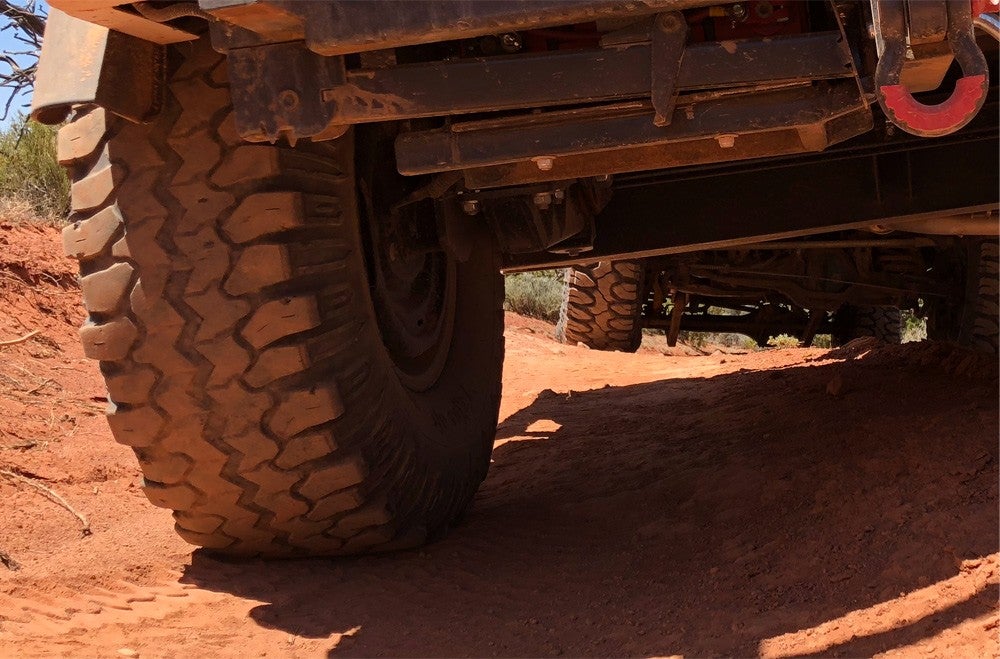
Timbren has muted all of that. The Axle-Less Suspension limits total travel to about 4”. That means the system remains relatively stable, with minimal up and down movement. Its behavior remains predictable and subdued, but also isn’t able to take big hits. Conversely, when hits happen (and they always will when towing off-road), the suspension can tend to bounce rather than soak up the impact. And yet, it also exhibits none of the ricochet effect that a rebounding leaf spring tends to exhibit.
Another difference between the two suspensions is aptitude for over compression and extension. The Dinoot’s leaf spring system would, on more than one occasion, compress so much that the tires impacted the fenders. This never occurred with the Timbren despite its limited range of travel. Likewise, the Timbren can’t droop more than 1-2”, and hence fails to remain as “planted” feeling as an appropriately rated leaf spring system.
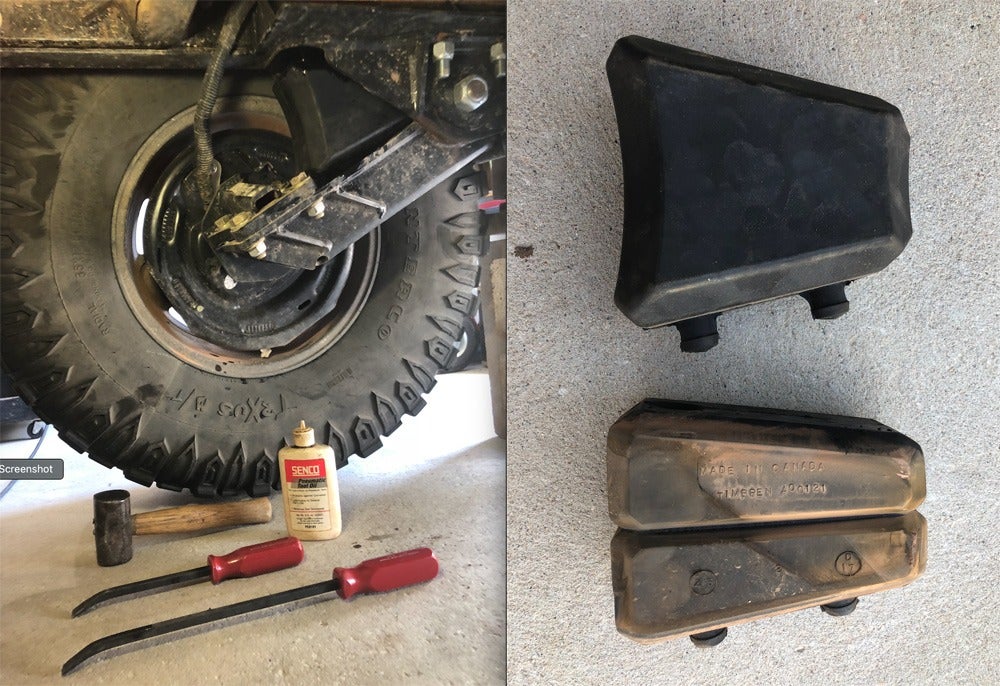
Heading to the trail, the stability of the Timbren makes it utterly forgettable. The system is a pleasure to tow in town, at 80mph on the interstate, or down your typical Forest Service road. On modest washboards, the Timbren is up to the task of absorbing the dirt corrugations. The opposing Aeon rubber responds rapidly, handling dips and divots at speed when their depth remained under about 4”.
Shop for Timbren Suspension Systems
In approximately 7,000 miles of use, the Timbren has remained unchanged in its performance or conditions. The stout build quality of the armatures shows only modest degrading of the finish from paint chipping. Sag has not been evident, and dampening qualities seem unchanged.
Where does the system show its weaknesses? That question depends on the vehicle you tow with. As I teach in my Overland Expo classes on trailers, your tow vehicle + your trailer are a system. They should be matched to one another to avoid unsafe dynamics, and to improve driving enjoyment. Weight, width, tire size and (especially) suspension for the trailer should be appropriate for your vehicle. In particular, the trailer’s suspension should be at least as capable as the truck’s. Why? Because trailers receive a great deal of abuse to begin with, and if yours is less capable than the truck then it probably can’t absorb the forces it encounters.
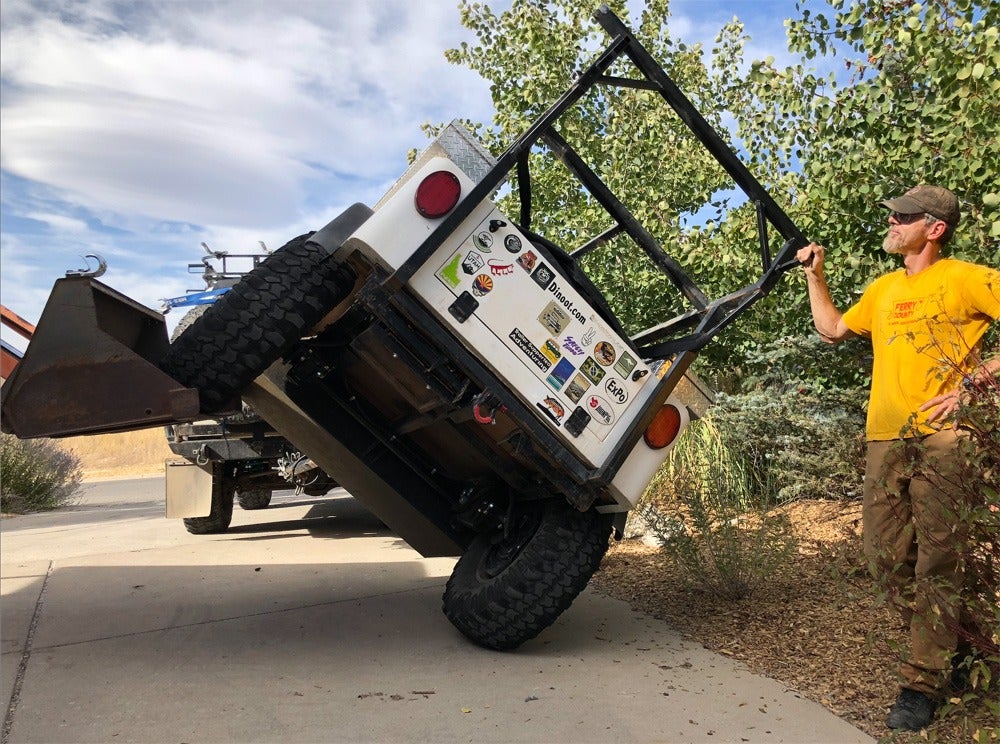
Timbren designed its system not for desert racers or rock crawlers, but for those who pull their trailers over moderate to challenging terrain. It doesn’t possess the impact dampening abilities for harder core wheeling IF you want to tackle such terrain at the pace a well-equipped 4×4 can go. However, if you’re willing to take your time, ease over obstacles, adjust tire pressures, and limit big hits into holes and washes, then the Timbren system can go anywhere a leaf spring or advanced trailing arm suspension can go.
In my years of teaching and traveling with those who tow off-road, hard-core terrain isn’t what they find attractive. While I personally enjoy the challenge of towing on technically complex trails, most drivers – I’d estimate 90% – will tow on trails and at speeds that are well within the Axle-Less Suspension’s designed intent. For such folks, a simple, reliable, high clearance trailer suspension like Timbren’s is going to be a great fit.
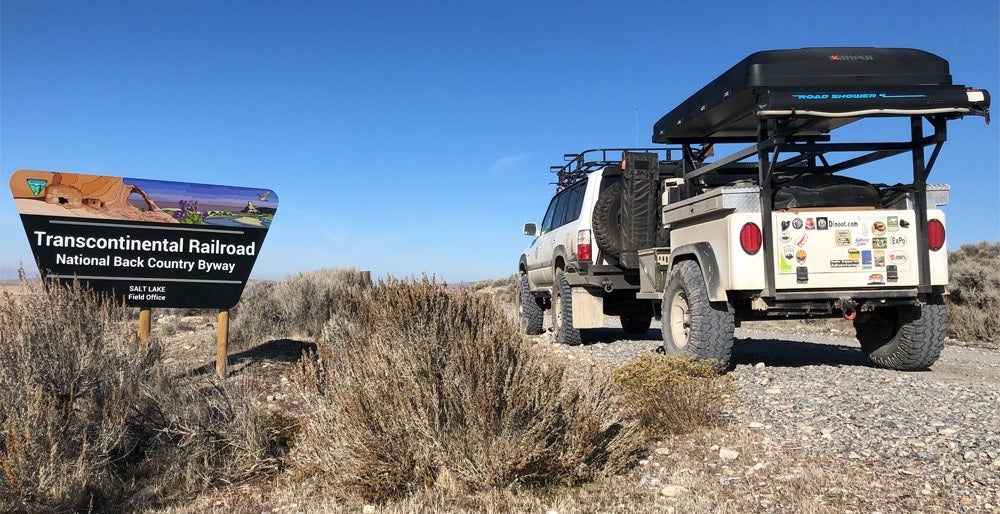
Similarly, Timbren’s SES components offer another simple, reliable suspension addition that has helped our tow vehicles (whether towing or not) absorb rapid compressions. In several instances, when towing at speed in the desert and unexpectedly coming upon drops (e.g., wash-outs, recessed cattle guards, ledges), the SES springs have mellowed out the blow. Impacts that had previously been felt as hard hits to driver and passenger, with the SES installed become mellow compressions (mostly due to the rear SES units, where suspension overload is most prominent).
REDARC Trailer Brakes
Of the ten or so trailers we’ve built/bought, none had trailer brakes. The reasons why varied. Mostly it was due to budget or the trailer’s light weight. When we designed a custom Dinoot in 2012 the result was a 700-pound ‘go anywhere’ caravan that had minimal effect on braking. As a result, we never bothered with trailer brakes (although the hubs were fitted for them). But trailers, like rigs, only get heavier. Fast forward several years and it was obvious when working with Timbren to spec its Axle-Less Suspension that it was time to add brakes. The only question was which controller to use?
In North America, the default controller is the boxy Tekonsha. These and similar devices are meant for easy installation (brackets allow them to be attached around the driver’s legs), and offer very basic braking controls. What they’re not meant for is off-road towing. Or staying out of the driver’s way.
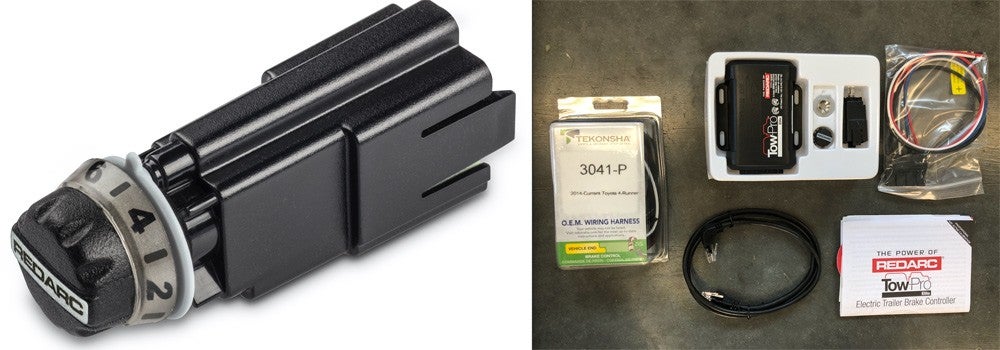
To find a built-for-the-trail brake controller we had to go to Australia. Or at least we went looking into the Australian 4×4 market, and what we found, once again, is that the Aussies were already bringing their inventions to the U.S. REDARC Electronics, which celebrated its 40th anniversary in 2019, began hitting our shores in 2017. Focusing on 4×4 electronics, particularly within the spheres of braking and onboard power (e.g., solar), REDARC makes purpose-built systems for those who travel in the deep outback and other remote areas.
REDARC offers only two controllers. But those models – the Tow-Pro Classic and full-featured Tow-Pro Elite – are sophisticated, and physically discreet. Their electronic guts are designed to be hidden, installed in a concealed manner behind the console/dash. Their presence is evident not from how they bang your knee (like the Tekonsha) but by an almost factory-looking control knob (about the size of a grape).
Shop for REDARC Trailer Brakes
In both our 4Runner and Land Cruiser we installed a Tow-Pro Elite in 2018. Using one of Toyota’s pop-out accessory plates, both rigs had a mounting location that allowed for easy access for adjustments while driving. This is important because REDARC designed the award-winning system with numerous driver control options. All of these are selected through the LED backlit control knob, and allow adjustment of braking type and responsiveness. From near zero effect to full lock up, the Tow-Pro system let you effortlessly dial (1-10 levels) in just the right braking power for the conditions or load you are facing.
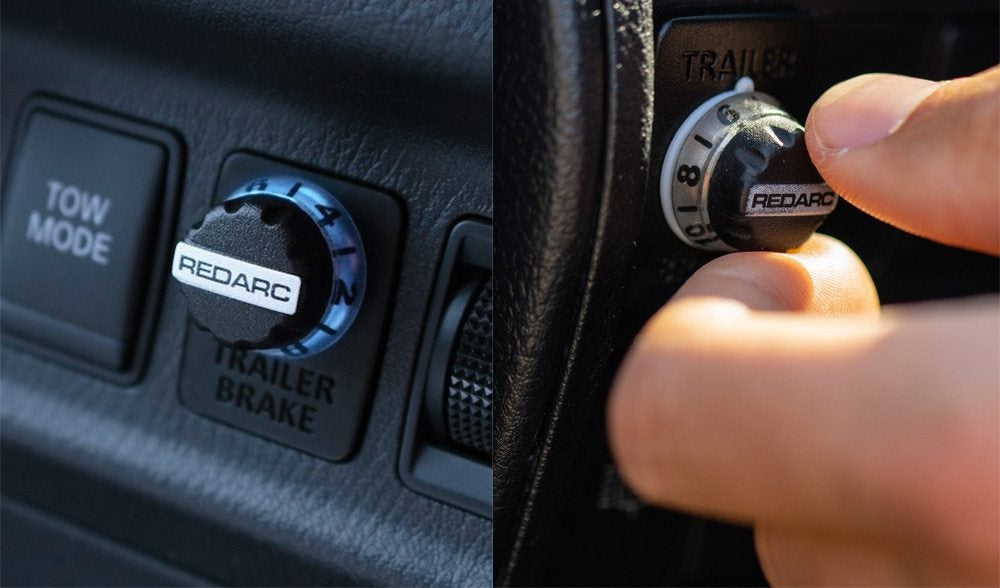
For someone who has towed for years sans brakes the addition of brakes and the Tow-Pro Elite is a revelation. Call me a slow learner, but the light bulb really went off as I began to experiment in off- and on-pavement situations. From stop-n-go traffic, to descending trails slick with mud or snow, the system dramatically improves safety, as well as perspiration levels. One of the most game-changing benefits is how the Tow-Pro will let you make the trailer an anchor, its brakes being applied harder and thus keeping truck and trailer in a straight line on steep and/or slippery descents. This is the “user-controlled mode.” It also lets you gradually reduce braking, such as when you don’t want the trailer to bite in as hard as the truck (e.g., on sand).
REDARC Tow-Pro Elite is the only controller with 3 types of control: proportional (inertia-based), user-controlled mode, and override mode (applies trailer brakes only). The system’s options for controlling braking are truly impressive. One, two or three axle trailers, the Tow-Pro is able to control them. Versions are even available for either 12v or 24v vehicles. Quite simply, the Tow-Pro Elite is THE brake controller for off-road or overland towing. In fact, for any serious towing, its design overshadows any other controller on the market. As a result, it transforms lowly electric drum brakes on a trailer into an adjustable, high performance control system. Given the health, safety and insurance ramifications of trailer towing, REDARC controllers seem more like basic equipment than a specialty item.
Conclusions
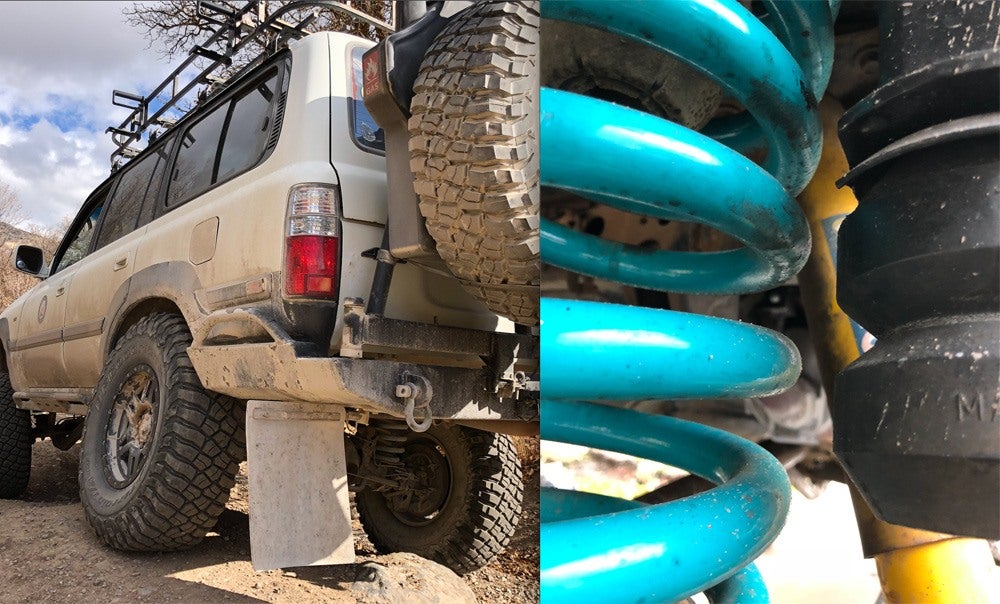
Used in combination, Timbren’s SES springs, their Axle-Less Suspension, and REDARC’s Tow-Pro Elite offer an effective system for absorbing and avoiding (through braking) trail impacts that can be unsettling or even dangerous. 4×4’s and their trailers must operate as a single, matched unit, and these products give new options for making the two systems work in concert.
The folks at Timbren have created a trail-capable system that is quickly becoming a top choice among overland and adventure trailer manufacturers. The reasons why become apparent once you’ve experienced its behavior. The Ontario, Canada company has produced a reliable, low maintenance, rugged independent arm suspension that can cover the needs of the majority of 4×4 enthusiasts who plan to tow in the backcountry. When paired with REDARC’s cutting-edge braking system, the results make it easier to forget that thing blocking your rear-view mirror.
Shop for Timbren Suspension Systems
About the Gear Doctor: Dr. Sean Michael has been designing, abusing and testing outdoor gear since the 1980’s, and began reviewing for Off-Road.com in 2000. Today, he is Professor of Outdoor Product Design & Development at Utah State University, a product consultant, and a frequent Instructor at Overland Expo. Follow his trips and gear @thegeardoctor on Instagram.
We are committed to finding, researching, and recommending the best products. We earn commissions from purchases you make using the retail links in our product reviews. Learn more about how this works.
